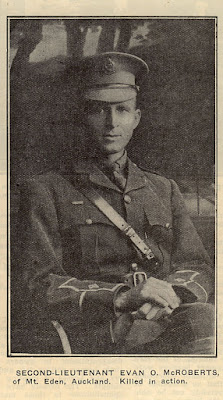 |
| Second-Lieutenant Evan O. McRoberts of Mt Eden, Auckland, Killed in action NZ Sport and Dramatic Review 8 Nov 1917 Auckland Museum Cenotaph |
 |
| Welcome Bay, Tauranga, postcard Image © and courtesy of Tauranga Heritage Collection |
Narrow Escape of a Boating Party: A narrow escape from drowning befell a party of picnickers yesterday afternoon in the arm of the harbour behind Matapihi. It appears that Mr G. E. Spooner with his wife and her sister, Miss Garland, and Mr E. Roberts went for a sail up the arm of the harbour between Maungatapu and Matapihi, and when in deep water a squall capsized the boat, from the leeward side, thus throwing all the occupants into the water and under the sail of the boat. After considerable exertion the whole party extricated themselves, and the ladies having been got on to the keel of the boat, it was decided that McRoberts, being a strong swimmer should try and get help from the shore. Accordingly he struck out and after a long swim only reached the Matapihi shore to find no boat available, and then with rare courage, took to the water again with the intention of crossing the wide and rough channel between Matapihi and Maungatapu. After an exhausting swim against wind and waves, most fortunately he was seen by two Maori who called to Mr F. Chappell, who was working on the new church, and he with one of the Maori at once went to McRoberts’ rescue, picking him up greatly exhausted, but nevertheless able to explain the predicament of his friends. The rescue party immediately pulled with all speed in the direction indicated and succeeded in taking off the other three, who were also in an exhausted state having been in the water over an hour, and the boat having turned over with them several times. The party was landed and helped by the Maori to a house which was placed at their disposal in a most hospitable manner by the Moaris, who did everything they could for the comfort of the unfortunate people and looked after them all night, enabling them to return to their homes this morning little the worse for their trying experience. Too much cannot be said for the courageous conduct of McRoberts, who, by the way, is a member of the local Post Office Staff, for whether or not the other members of the party might possibly have been rescued by the means in his absence, he undoubtedly took his own life in his hands, and narrowly escaped losing it, in carrying out his manly intention to save them at all hazards to himself.For his brave actions he was awarded a Royal Humane Society Silver Medal and Certificate.
Remarkably Evan’s brother Constable Wilfred McRoberts also received a Royal Humane Society Medal for life saving (Grey River Argus, 4 March 1916).
Case Number 438 Wilfred Gilmore McRoberts, Bronze Medal. On 3 March 1916, Alexander T. Emmis 49, was bathing on the beach at Greymouth, and being caught in a strong backwash was carried out to sea. When the alarm was given the lifeline was procured, and Constable McRoberts, 35, of Greymouth, immediately volunteered to swim with the line in order to affect a rescue, and after a hard struggle against the heavy sea that was running, he managed to rescue Emmis, who was in a very weak and exhausted state.
Sadly both McRoberts brothers would have their own lives cut short. Evan was killed in action 4 October 1917 and Wilfred died in November 1918 of influenza. His obituary referred to him as a “fine stamp of a man” and a very popular police officer. Evan left behind a wife and child and Wilfred a wife and 3 children.– Zealandia’s Brave, The Royal Humane Societies in New Zealand 1850 to 1998, John D Wills.















